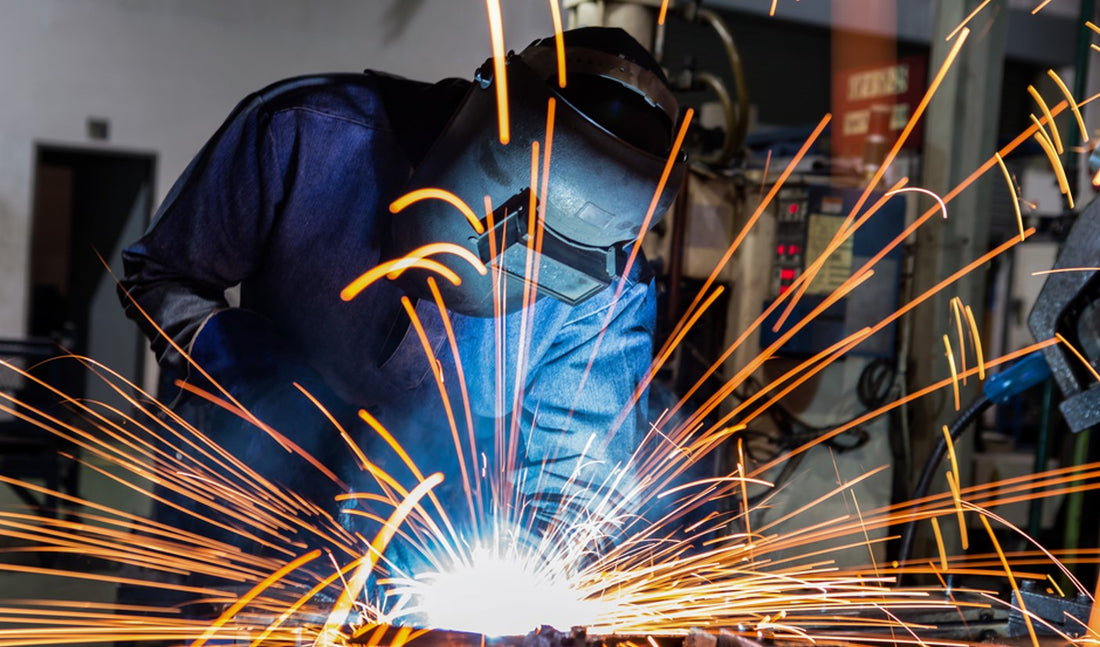While all types of welding involve joining pieces of metal together using a combination of heat and pressure, various welding techniques exist. Each type is suited to different projects' unique needs, so it is well worth familiarizing yourself with them to become a more knowledgeable welder.
To help you learn about the most common types of welding, we will provide an overview of each type and even cover some of the advantages of each method.
The Most Common Types of Welding
To give you an idea of the various types of welding, we will cover the most common types, as well as the different methods within those types.
1. Arc Welding
When most people picture welding, what they imagine is arc welding. It is the most common type of welding used by professionals, hobbyists, and part-time craftsmen.
This type of welding relies upon creating an electric arc between an electrode and the base metal being melted and fused to bond objects. Within arc welding, there are some variations:
a) Shielded Metal Arc Welding (SMAW)
Shielded metal arc welding, also known as stick welding, is a unique welding process that relies on an electric arc being created between a consumable electrode and the base metal used to create the weld.

It is very simple to perform and extremely versatile, as the welder can easily maneuver their body to weld on various angles, and the equipment is relatively portable. With SMAW, the electrode has a metal core coated in a flux material, protecting the weld area from oxidation and debris. The flux also helps protect the weld by generating a slag that covers the weld bead.
b) Gas Metal Arc Welding (GMAW)
Gas metal arc welding is more commonly known as MIG welding. It is a type of arc welding that creates an electric arc between a continuously drawn-out wire electrode and the base metal. The welding gun itself helps protect the weld from contamination by providing a shielding gas, which can be argon, helium, or a mixture of the two.
Like stick welding, GMAW is very popular across various industries, as it works with various metals, is relatively easy to do, and is incredibly fast. It is particularly common in auto repair and construction.
c) Gas Tungsten Arc Welding (GTAW)
GTAW, also known as tungsten inert gas welding (TIG), uses a tungsten electrode and a filler rod. The electrode creates an arc when it comes in contact with the base metal, which melts the filler metal and creates a joint.
While this type of arc welding requires practice, one of its main advantages is that it works well on thin pieces of metal.
d) Plasma Arc Welding (PAW)
Plasma arc welding involves a similar process to gas tungsten arc welding but involves much higher temperatures. The electrode is positioned within the torch, with plasma gas passing through a narrow nozzle beside it. The result is a highly focused and precise arc, which can be used to create thin welds.
Given that you need a plasma torch and a plasma gas supply, it is a relatively expensive type of welding, but it certainly has its advantages.
For more information on arc welding, we highly recommend reading Arc Welding 101 – A Beginner’s Guide.
If you are unsure which type of arc welding is right for your needs, you can also read MIG vs. Tig Welding – Which Is Right for You?
2. Resistance Welding
Resistance welding is different from arc welding because it relies more on pressure to fuse metal pieces together than heat generated by an electric arc. Electric current is passed through metal pieces, generating a significant amount of pressure and heat. When this is done in a controlled manner, the metal pieces will become fused.
Like arc welding, there are various forms of resistance welding.
a) Seam Welding
Seam welding involves creating a continuous, uninterrupted weld along a joint. Seam welding machines use rotating wheels positioned on either side of the joint. When continuous pressure and electric current are applied along the joint, a series of overlapping spot welds are created, which hold the two pieces of metal together.
The advantage is that seam welds create a solid, leak-proof weld.
b) Spot Welding
Spot welding involves a similar process to seam welding, but, as the name implies, it involves creating spots of welded metal, like pinning a material to another, rather than sewing the two together.
It is ideal for creating discrete welds at specific points, as it is incredibly fast and efficient. The welds are also very strong, especially for their small size.
3. Gas Welding

As the name implies, gas welding involves using a flame that combines a fuel gas with oxygen and heat. The result is high temperatures that can melt and fuse metals. It can be used on various metals, including some with relatively high melting points, like steel.
To gas weld, you will need a welding torch, fuel cylinder, oxygen cylinder, regulators, fire-proof hoses, a welding helmet, and protective clothing. While it is a fairly simple form of welding, its versatility and relatively low cost explain why it is fairly common.
Final Words
Each welding type discussed above offers its unique advantages and disadvantages. They are also designed for specific welding applications, so it is worth learning the differences between them.
For more information on the various types of welding and their differences, you can also read The Different Types of Welding Explained. This straightforward guide explains the pros and cons of the various types and what each is used for.
You can also visit the SIMPLE WELD Welding Shop for high-quality Welding Rods, MIG Wire, and Welders.

